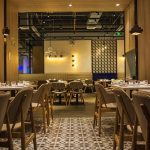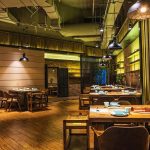Furnishing a restaurant is about more than just selecting tables and chairs—it’s about creating a space that enhances guest experience, maximizes comfort, and aligns with your restaurant’s theme. Understanding how to furnish a restaurant is crucial for creating an inviting and practical dining environment. The right furniture affects customer satisfaction, seating capacity, and the overall ambiance, making it a key factor in your restaurant’s success.
Understanding how to furnish a restaurant is crucial for creating an inviting and practical dining environment. The right furniture affects customer satisfaction, seating capacity, and the overall ambiance, making it a key factor in your restaurant’s success.
In this guide, we’ll explore the best strategies for selecting restaurant furniture, arranging seating layouts, and designing an efficient dining space to ensure your restaurant is both stylish and functional.
Table of Contents
Toggle- Key Considerations When Furnishing a Restaurant
- Enhancing Restaurant Aesthetics with Stylish Décor
- Final Thoughts on How to Furnish a Restaurant
- Restaurant Furniture Layout
- 4 Tips for Furnishing your Restaurant
- How to choose furniture for your restaurant
- What is the role of color in restaurant interior design?
- Most popular wood types for restaurant furniture
- How to choose the right tabletop material
- Psychology of Restaurant Designs
- How to Choose Timeless Furniture for your Hotel
- Turkish Restaurant Furniture Options
- Restaurant Furniture Istanbul
- Restaurant Bar Chair Ideas from Turkey
- Metal or Plastic Chair for your Restaurant in Turkey
- Restaurant Chair Produced in Turkey for Indoor and Outdoor
- Selecting Restaurant Tables Made in Turkey
- Designing Restaurant Booth Seating From Turkey
- 7 Things to Consider Whilst Designing a Restaurant Furniture Layout
- The Guide to Planning and Buying Restaurant Tables and Chairs Made in Turkey
- Advantage of Booth Seating Made in Turkey
- What type of restaurant chair should you prefer – wooden, metal, or plastic?
- Building A Unique Atmosphere
Key Considerations When Furnishing a Restaurant
1. Choosing the Right Furniture for Your Restaurant Theme
Your restaurant’s theme influences the type of furniture, materials, and colors that will best complement your space. The goal is to create a cohesive look that reflects your brand identity.
Fine Dining Restaurants: Opt for upholstered chairs, elegant wooden tables, and sophisticated lighting.
Casual Dining & Cafés: Combine modern and rustic elements with comfortable seating and stylish décor.
Fast Food & Quick Service: Use durable, easy-to-clean furniture that allows for high seating turnover.
Tip: Choose furniture that aligns with your restaurant’s ambiance to create a seamless customer experience.
2. Selecting Durable and Comfortable Seating
A restaurant’s chairs, booths, and barstools must be comfortable, stylish, and long-lasting. Customers are likely to spend more time dining when they feel at ease, so seating is a critical factor in restaurant furnishing.
Wooden chairs provide a classic touch and work well in traditional and casual settings.
Metal chairs and stools are ideal for modern and industrial-style restaurants.
Upholstered seating adds comfort but requires stain-resistant materials for easy maintenance.
Tip: Use a mix of seating options like booths, bar stools, and standard chairs to accommodate different dining preferences.
3. Optimizing Space with a Functional Restaurant Layout
An efficient restaurant layout ensures that guests feel comfortable while staff can move freely. The right arrangement will maximize seating capacity without making the space feel overcrowded.
Allow at least 24–30 inches between tables for easy movement.
Ensure at least 36 inches of walkway space for seamless staff and guest mobility.
Use flexible seating layouts that can be adjusted for large groups or private dining areas.
Tip: A well-planned restaurant space layout balances guest comfort with operational efficiency.
4. Choosing the Best Restaurant Tables for Your Dining Space
Tables are a central element of restaurant design, and selecting the right ones affects functionality and aesthetics.
Round tables encourage conversation and are great for small groups.
Square and rectangular tables allow for flexible seating arrangements.
Communal tables create a social dining experience in trendy and modern spaces.
Tip: Use scratch-resistant and easy-to-clean surfaces for high-traffic restaurants to maintain quality over time.
Enhancing Restaurant Aesthetics with Stylish Décor
1. Incorporating Color and Lighting
The right color scheme and lighting setup play a huge role in setting the mood of your restaurant.
Warm colors like red and orange stimulate appetite, making them ideal for casual dining.
Cool colors like blue and green create a relaxing atmosphere.
Soft, dim lighting works well for fine dining, while brighter lighting is ideal for fast-casual eateries.
Tip: Use pendant lights, recessed lighting, or chandeliers to enhance your restaurant’s ambiance.
2. Adding Decorative Elements for a Unique Touch
Wall art and murals can reinforce your brand identity.
Plants and greenery add a fresh, inviting feel to any space.
Statement furniture pieces (such as a unique bar counter or lounge chairs) create visual appeal.
Tip: Use decorative elements that complement your restaurant’s furniture and color palette for a cohesive look.
Final Thoughts on How to Furnish a Restaurant
Furnishing a restaurant requires thoughtful planning, quality furniture selection, and a strategic layout to ensure a comfortable and visually appealing dining environment. By following these essential tips on how to furnish a restaurant, you can create a space that enhances customer satisfaction and improves overall efficiency.
Key Takeaways:
Choose restaurant furniture that aligns with your brand identity and theme.
Invest in durable, high-quality materials for long-term use.
Optimize space with an efficient layout that allows smooth traffic flow.
Select tables and chairs that maximize both aesthetics and functionality.
Enhance ambiance with lighting, color schemes, and decorative elements.
By incorporating modern restaurant furniture ideas, durable tables, and stylish décor, you can create a memorable dining experience that attracts and retains customers.



